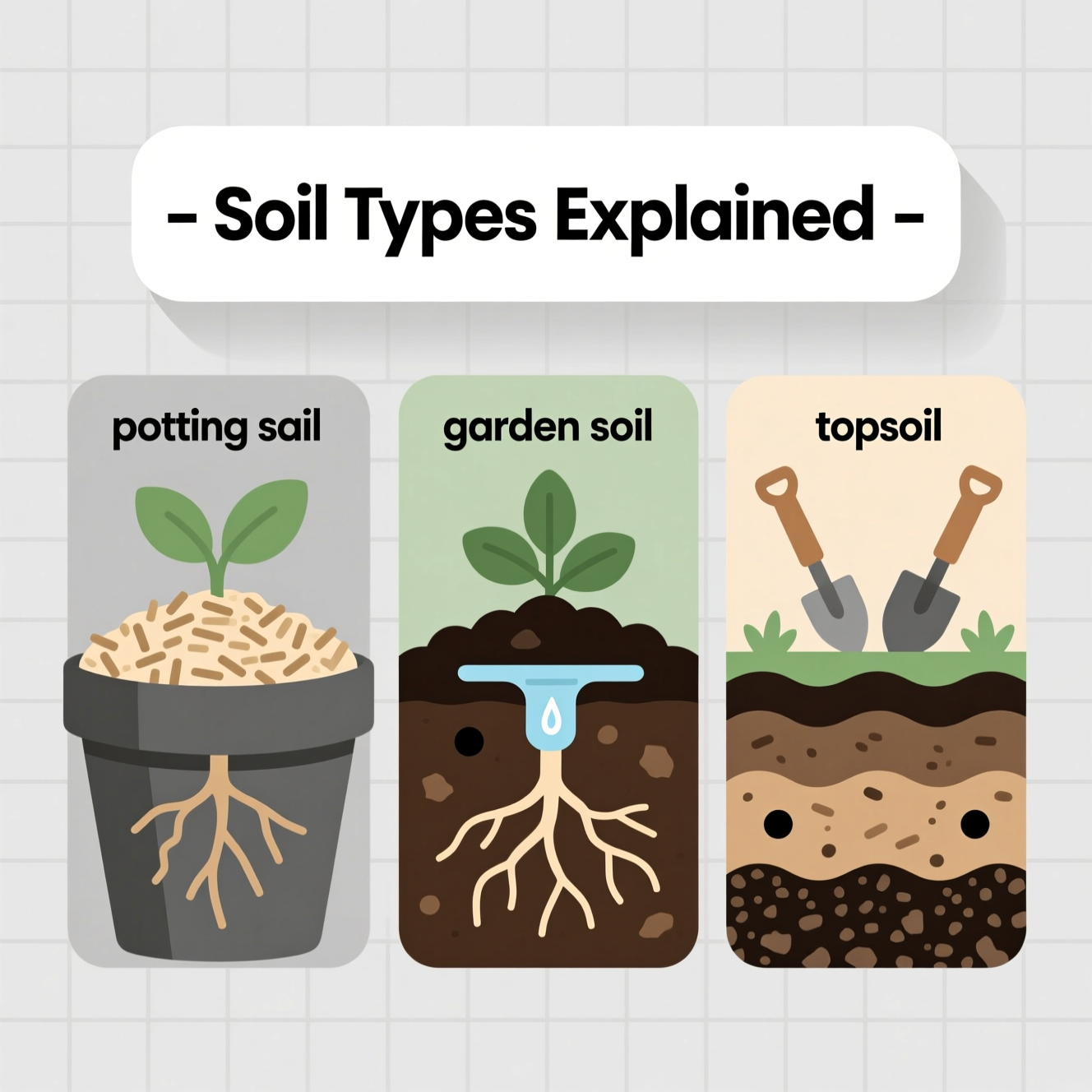What Are the Fundamental Differences Between Potting Soil, Garden Soil, and Topsoil?
Understanding soil types is crucial for successful gardening. Potting soil is specifically engineered for containers, emphasizing excellent drainage and aeration. Garden soil is often a blend of amended topsoil and compost. Topsoil itself represents the uppermost layer of the earth’s surface, rich in organic matter and minerals.
Potting soil typically contains a mix of organic matter like peat moss or coco coir. It also includes amendments for improved drainage, such as perlite or vermiculite. This specialized blend ensures adequate air pockets; for instance, properly formulated potting mix offers superior aeration, with air pockets often comprising 20-30% of its volume. Garden soil is frequently topsoil enhanced with compost to improve its soil structure and nutrient content.
In contrast, natural topsoil can be dense and compacted, lacking the essential drainage and aeration characteristics needed for potted plants. For most gardeners, using the correct soil type directly impacts plant health, influencing root development and water retention. This distinction is vital when comparing potting soil vs garden soil for various horticultural applications.
What Makes Potting Soil Ideal for Containers and Indoor Plants?
Potting soil is specifically engineered for the unique demands of container gardening. Unlike garden beds, pots rely on artificial drainage. This specialized soil mix ensures superior aeration and drainage, preventing waterlogging and the dreaded rootbound condition that can afflict indoor plants. Its formulation is key for healthy root development in confined spaces.
Modern experts emphasize a potting mix that balances water retention with excellent drainage. This critical characteristic prevents soil compaction, a common issue in pots. For most gardeners, container soil mix should promote robust growth. Potting soil is often sterilized for optimum plant health. This sterilization eliminates pathogens and weed seeds, ensuring a clean start. Container plants watered with a well-draining potting mix show a 50% reduction in root rot incidence compared to compacted soil. This level of performance is vital for successful indoor plant soil cultivation.
How Does Garden Soil Differ from Topsoil, and Where Should It Be Used?
Garden soil is processed for superior performance in cultivated areas. It typically involves screened topsoil blended with organic matter. This formulation enhances soil fertility and structure. For most gardeners, garden soil is ideal for amending garden beds and creating new ones, promoting robust root development. Topsoil, while nutritious, can become dense, hindering aeration if used alone.
In practical terms, amending soil with compost can boost water retention by up to 15%. This improved moisture management is crucial for plant health. Unlike raw topsoil, garden soil is designed to reduce soil compaction. Its composition ensures better drainage and increased oxygen availability to roots. This makes it a preferred choice for raised beds and vegetable gardens.
Can You Use Topsoil Directly in Garden Beds or Containers?
Directly using topsoil in garden beds or containers is generally not the optimal approach for most gardeners. While topsoil forms the foundation, it often lacks the balanced structure and fertility needed for robust plant growth. For instance, using topsoil directly in containers can lead to significant drainage issues. This is because it can exhibit a high clay content or sandy texture, impacting aeration.
In practical terms, unamended topsoil can suffer from soil compaction, potentially restricting root penetration by as much as 40%. This density hinders nutrient and water uptake. Furthermore, topsoil may introduce unwanted weed seeds and harbor pathogens that can affect plant health. Modern best practices emphasize amending topsoil with compost to enhance its structure, boost fertility, and support healthy microbial life.
Is It Ever Okay to Mix Potting Soil with Garden Soil or Topsoil?
Mixing potting soil with garden soil or topsoil is often advisable for enhancing specific soil properties. When considering how to blend these components, remember that potting mixes offer excellent aeration and drainage. This makes them valuable soil amendments for heavy clay garden soils. For most gardeners, understanding this can significantly improve plant health.
In practical terms, adding potting mix to garden soil can improve aeration by up to 20%. A blend of 30% potting mix added to garden soil can improve overall soil aeration and drainage by approximately 15%. Conversely, for sandy soils, potting soil can help retain essential moisture and nutrients. This soil blending for gardens ensures a more balanced environment, promoting robust root development.
However, avoid using pure potting soil in large outdoor beds. Such applications may not provide adequate soil structure needed for established plants. By carefully considering soil amendments, you can achieve optimal drainage and a better nutrient balance, aiding in disease prevention for your garden.
What Are the Signs That My Potting Soil Has Gone Bad or Needs Refreshing?
Recognizing bad potting soil is key to healthy plants. Persistent water repellency indicates poor structure. Visible mold or fungal growth on the surface signals an imbalance. Stunted plant growth and the presence of pests like fungal gnats are also clear indicators of depleted soil. The soil pH can also shift significantly over time, impacting nutrient availability and plant vigor.
Soil compaction is another common issue, hindering root aeration and water drainage. Old potting soil often loses its beneficial microbial populations. These microbes are crucial for nutrient cycling and plant health. Soil pH deviations of more than 1.0 point from the optimal range can reduce nutrient uptake by 30% or more, impacting plant performance.
How Do Raised Garden Beds Impact Soil Choice: Garden Soil vs. Potting Soil?
Choosing the right soil is crucial for raised garden beds. For most gardeners, a blend of garden soil and compost offers excellent structure and fertility. This mix typically provides the necessary drainage and aeration for robust root development. Pure potting soil, while useful for containers, can be too light for the volume and depth of raised beds.
Raised beds filled with a balanced mix can offer 2-3 times the aeration of in-ground planting sites. This improved soil aeration is vital for preventing soil compaction. In practical terms, a common recommendation is a mix of 60% garden soil and 40% compost. This blend ensures adequate moisture retention while preventing waterlogging and promoting healthy soil depth.
Furthermore, the substantial volume of raised beds benefits from the cost-effectiveness and long-term stability of garden soil mixes. This approach enhances overall plant health and yield. Understanding these differences ensures optimal conditions for vigorous growth in your raised garden beds.

Tyler Grant runs our Tools & DIY testing lab, putting pruners, hoses, drip kits, and raised-bed systems through real-garden use. He documents builds, timings, and durability to deliver honest pros/cons and clear recommendations across budgets. Tyler’s guides include safety callouts, maintenance checklists, and step photos you can follow in a weekend.

